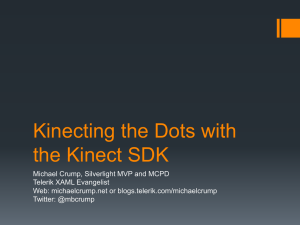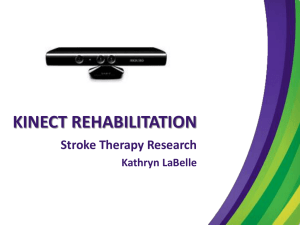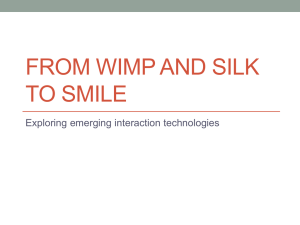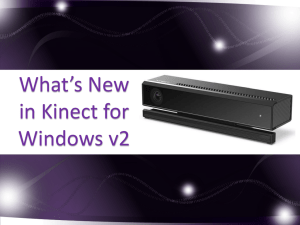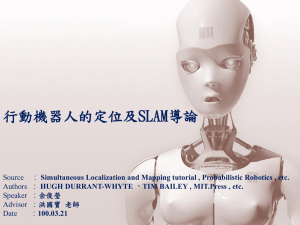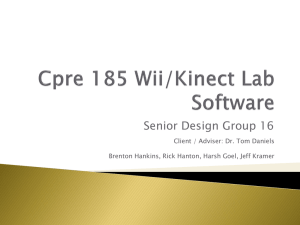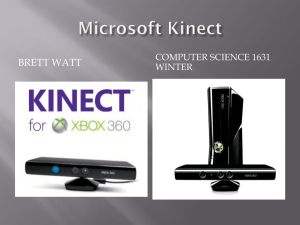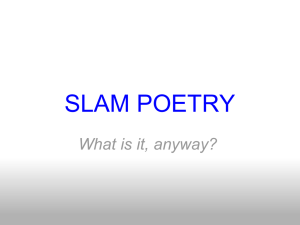Final Presentation Slides - 3D Mapping with Microsoft Kinect
advertisement
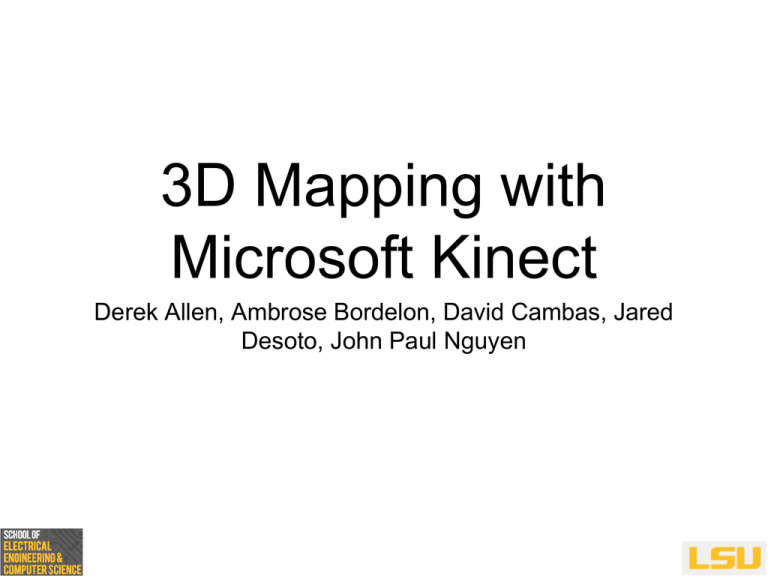
3D Mapping with Microsoft Kinect Derek Allen, Ambrose Bordelon, David Cambas, Jared Desoto, John Paul Nguyen Background Computer Vision: The act of getting computers to ‘see’. Machine Vision: A branch of computer vision, focused on physical robots ‘seeing’ and reacting to what they ‘see’. Project Overview Create a 3D model of an unexplored room utilizing the Microsoft Kinect. • Model of the room should be generated as quickly as possible. • Model generated should be as accurate as possible. • Platform should be cheep and easy to operate. Project Management • Break up coding into 4 parts: – Program the interface between Kinect and computer – Program the raspberry pi and zigbee to allow for wireless communication – Develop a SLAM algorithm to stitch together images from the sequence of Kinect images – Develop a visualization application to view the final reconstructed point cloud as a 3-D model The Kinect • • Cameras • 30fps • 640 x 480 IR Emitter • • Reconstruction detail Tilt Motor • 27° tilt radius iRobot Create • C or C++ • Cargo Bay • Wheel Clips • Weight Capacity • Travel Speed Raspberry Pi B+ • 85 x 56 x 17mm • C++ • 4 USB Zigbee XBee • Wireless communication • Passive Protocol • • Initiator starts communication 72 Mbps SLAM • RGBD SLAM • Scale-Invariant Feature Transform (SIFT) • • Object Recognition • Image Stitching Random Sample Consensus (RANSAC) • Inliers and Outliers RANSAC Programming Programming Our Reconstruction Application Tool to Write Kinect Depth Stream as Image Format Tool to Transmit Raster Images Wirelessly Tool to perform SLAM on Image Sequence Tool to Visualize Final Model Programming Depth Stream Tool openni2 Kinect Fusion libfreenect Programming Depth Stream Tool openni2 Kinect Fusion libfreenect Programming Depth Stream Tool Transmit Tool python programming language bash shell cpp language Programming Depth Stream Tool Transmit Tool SLAM Tool Point Cloud Library OpenCV RGBDSLAM Programming Depth Stream Tool Transmit Tool SLAM Tool Point Cloud Library OpenCV RGBDSLAM Programming Depth Stream Tool Transmit Tool High Level Low Level SLAM Tool Visualization Tool Programming Depth Stream Tool Transmit Tool High Level Low Level SLAM Tool Visualization Tool Programming Depth Stream Tool Transmit Tool Visualization Tool SLAM Tool Our Reconstruction Application Tool to Write Kinect Depth libfreenect Stream as application Image Format C++ RGBDSLAM openframeworks application Testing Hardware and Software each will be broken into units. These units will be tested independently in ‘Unit Tests’, then tested working together in ‘Integration Tests’. Hardware Units Include: • Kinect • iRobot Create • Microcontroller with Wireless adaptor Testing Software Units will be independent functions, where each function will have set inputs from which certain outputs are expected. Software Units Include: • Input Data Management • Model Generation • Blind Spot Detection • Obstacle Detection • Path Generation • Robot Movement Control Notes on Testing • Software Units are subject to change as project develops. • Testing will be done as soon as possible, as often as possible. • Extensive testing will be time consuming, but feedback will allow fixing errors in an isolated environment. Will allow speedier development in the long run. Deadlines and Timing • • • • • • 2/12/14 – Finish image stitching algorithm 2/25/14 – Test and Debug code 3/07/14 – Finish constructing robot 3/20/14 – Complete testing of basic robot 4/18/14 – Complete wireless integration 4/24/14 – Complete testing of wireless integration Executive Summary • • • • • 3-Dimensional Model using a Kinect Sensor Budget: iRobot create, Zigbee, Xbee, raspberry pi Divide the code into 4 subdivisions Devised tests and deadlines for our robot

